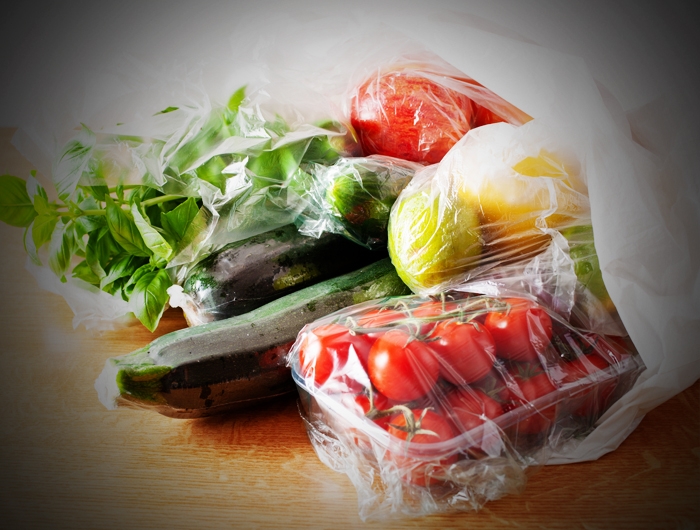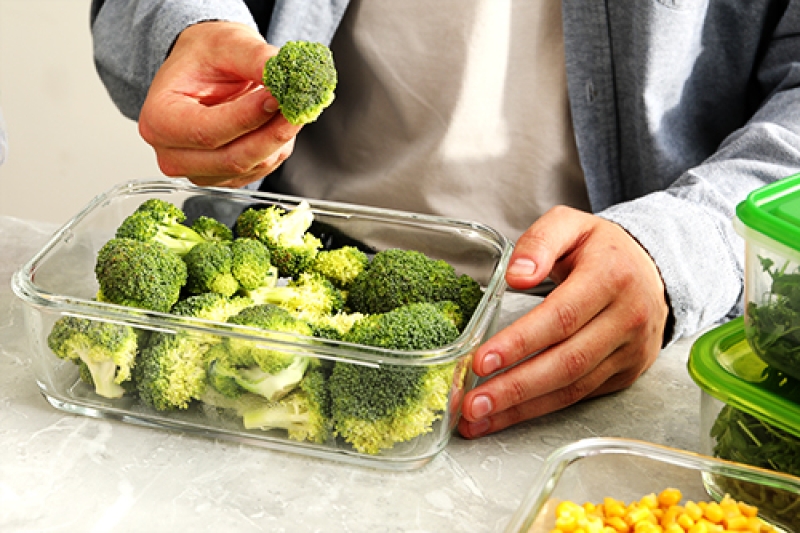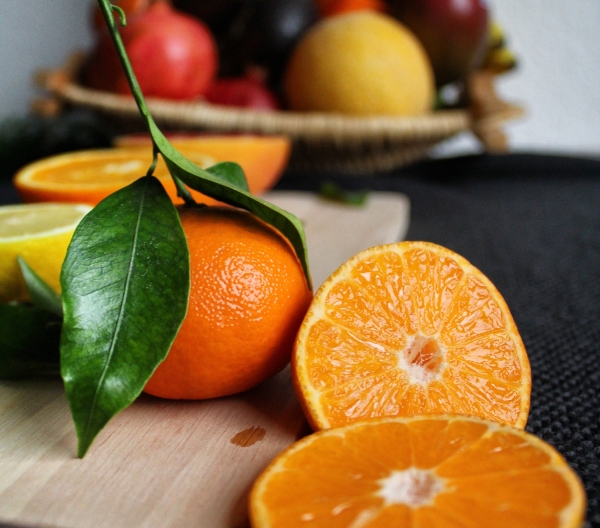Reduce plastic use at home—for the planet’s health and ours

Olga Miltsova - stock.adobe.com.
Single-use plastics, microplastics, and plastics that will never get recycled fill our air, water, and shelves. Here's why it matters... and what you can do to limit your contribution to the plastic problem.
The food industry has a lot of work to do in reducing its reliance on plastic. In the meantime, though, consumers have an important role to play too. We’ve put together some tips to help you cut back on plastic—especially single-use plastic—in the home.
Where are plastics found in the food system?
Plastic is everywhere on our planet. Although plastic has been commonly used only since World War II, it has worked its way into every corner of the globe and our food system, from drinking water to crop fields and the shelves in our homes.
Some examples are obvious to us. We find plastic in food packaging all over the grocery store, such as plastic bags, clamshell containers, plastic wrap, and plastic bottles. These plastic products come in all sorts of shapes and sizes, and are lightweight and durable, making them indispensable in many kitchens.
But we encounter much more plastic than we realize, because much of it is too small to see. The very qualities that make plastic so useful to us—mainly its durability—also make it detrimental to our health and the planet’s. Plastic is not biodegradable, meaning it does not decompose into the ecosystem. Instead, plastic turns into smaller and smaller pieces, eventually becoming microplastics. Microplastics are any piece of plastic smaller than 5 millimeters, but many of them are far too small to see with the naked eye.
Microplastics often find their way into our water system. Sixty percent of clothing fabrics are synthetic, and these fabrics shed microplastic fibers in the washing machine that end up in the water stream. About 95 percent of microplastics are filtered out through water treatment, but even the 5 percent that gets through means millions of microplastic particles in our water. Also, the sewage sludge that gets filtered out during water treatment is often used to treat agricultural soil because it is a great source of nutrients. Unfortunately, it is also a great source of microplastics, which may wind up in our food.
More from NutritionAction: Paper or plastic? How to pick your packaging
Why are microplastics dangerous?
All plastic is derived from fossil fuels, so producing plastic creates greenhouse gases that harm the planet and ultimately harm us. On top of that, many plastics contain additives like BPA and phthalates that can disrupt your endocrine system and have been linked to a range of health problems from fertility issues to certain cancers.
There isn’t much research yet on the effects of microplastics on our health, though microplastics may affect the digestive, respiratory, endocrine, reproductive, and immune systems and likely enter the body through inhalationt, and ingestion. For example, in 2021, researchers found microplastics in human placentas for the first time, indicating that microplastics are making their way through the bloodstream after we either inhale or ingest the fragments.
And microplastics are dangerous not just for humans. We know that microplastics accumulate and travel in waterways, and evidence suggests microplastics can impair the reproduction and growth of marine life. Microplastics get concentrated through the marine food chain, starting with plankton and accumulating in whatever eats them.
Some of this marine life becomes seafood on our plates, but it is far from the only dietary source of microplastics. Drinking water, beer, and sea salt have all been found to contain microplastics. Through dietary and environmental sources, one study estimated some people may be consuming a credit card’s-worth of plastic—up to 5 grams—each week.
Learn more at NutritionAction: Why microplastics are a mega problem
The recycling problem
Recycling is an important part of a sustainable world, but it’s not the catch-all solution corporate messaging often touts it as. Recycling plastic is incredibly difficult due to the sheer variety of plastics in use; only 5 or 6 percent of plastic thrown in the blue bin actually gets recycled. And even then, each time plastic is recycled, it becomes an inferior version of itself, limiting its longevity.
The U.S. recycling system puts the burden on consumers to know what’s recyclable and what’s not. Corporations often design products to appear more easily recyclable than they actually are. Many packages prominently display the ubiquitous “chasing arrows” symbol, which consumers interpret to mean the product will be recycled. The icon is usually paired with a number 1 through 7 that identifies the type of plastic used. Although most recycling services will collect plastic of all types, markets generally only exist for plastics 1 and 2.
When you combine consumers eager to participate in sustainable practices with a confusing and opaque recycling system, you get wishcycling: Tossing things in the recycling bin in the hopes that it will get recycled, despite the reality that it may in fact make things worse. Contributing non-recyclable material to the recycling stream adds to transportation costs, can back up machinery, and sometimes puts recycling workers in danger. So, while it requires more work on your end, stick to the motto “when in doubt, find out (what your local recycler accepts).” Taking that extra step may give you pause about buying products stored in certain types of plastic in the future, a concept called “precycling.”
Learn more at NutritionAction: 5 things to know about recycling
How can we cut back on plastic?

Reduce, reuse, and recycle are in that order for a reason. Recycling is better than throwing plastic in a landfill, and reusing is better than tossing out packaging or containers with plenty of life left in them, but cutting out plastic from the very start is the best way to minimize its harms.
Reducing our reliance on plastic is also the hardest step to take. The good news is that even small changes can have a big impact. Here are some ways you can reduce your use of plastic, and our best tips for replacing plastic items in your home.
- Cut out single-use plastics. This is the most important step in reducing plastic use. Carry a refillable water bottle rather than using disposable plastic bottles, use your own reusable straws and utensils when getting takeout, and bring containers from home topack up leftovers from a restaurant.
- In the grocery store, try to buy in bulk whenever possible, and look for foods in glass or metal containers, which are more easily recyclable.
- Opt for glass and metal food storage containers in your kitchen. They last indefinitely and are more environmentally sustainable than plastic.
- Try beeswax wraps instead of plastic wrap and bags. Many companies now make these, and they’re widely available in stores.
- Approach reusing plastic items as a creative exercise. How can I breathe new life into this yogurt container or old polyester t-shirt? Plastic is made to be durable, so it can often keep doing its job longer than we realize. Check out Earth911.com for recycling and upcycling tips and ideas, like what to do with old yoga mats or how to recycle your well-loved clothing.
- When you’re replacing clothing, look for secondhand options—and better yet, reduce plastic altogether by opting for natural fibers. Wool, cotton, rayon (often branded as Modal), and silk are natural fibers to look for.
- Plastic containers can be reused for years on end (but don’t use plastics for liquids or hot foods and don’t microwave plastic containers). When you choose to replace yours, use glass containers from packaged foods (like pickle jars) or look for glass options at secondhand shops.
- Stop using plastic grocery bags. Reusable grocery bags are often made of synthetic materials, so look for bags made from natural fibers like cotton or hemp—new or secondhand.
- The most sustainable option is the one you already own. Don’t throw out plastic if it’s still working for you. Just plan to replace it with a better option when its lifespan is at an end.
- You don’t have to do it all at once. Make a habit of looking for your high-repurchase products in plastic-free or compostable packaging. You can start with lip balm or chicken broth, and move into larger purchases, like new food storage, over time. Every little change counts!
More helpful tips from NutritionAction: How to cut back on plastic
The bottom line
Though most plastic pollution comes from industrial use, consumers can make real differences by reducing, reusing and recycling. And our ability to help the plastic problem isn’t limited to the three Rs, either. Consumers have a voice, and demanding more sustainable practices from corporations can encourage the industry to act.

Subscribe to Nutrition Action
We name names, remain strictly objective, and deliver scrupulously researched advice about food of all kinds, staying healthy with diet and exercise, and more.

